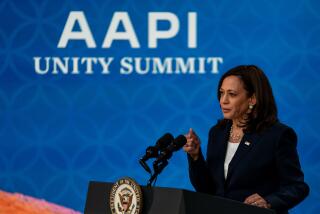Stymied by Stereotypes? : Asian Americans See Glass Ceiling at the Big Three
- Share via
DETROIT — As the Big Three auto makers regained their dominance of the U.S. car and truck industry in recent years, the workers who helped General Motors Corp., Ford Motor Co. and Chrysler Corp. reassert themselves included hundreds of Asian Americans.
Many of these employees work in technical fields as designers, researchers or engineers. Some hope to advance in the corporate hierarchy.
But some Asian Americans say that dream is elusive. They have found themselves hitting the “glass ceiling,” the invisible barrier to promotions that some people encounter at U.S. companies.
“If an individual from an Asian country decides to do research, then that will fit him or her well,” said David Chock, 50, a Chinese American supervisor in Ford’s research division. “If he or she wants to move into management, then he or she will run into a lot of frustration.”
More than a dozen Asian Americans at the Big Three said in interviews that they have not encountered overt discrimination. But some said stereotypes about Asian Americans--for example, that they excel in the sciences but not in verbal or interpersonal skills--hinder their advancement.
*
In some cases, they said, the stereotypes were backed by reality--some Asian Americans indeed lack English skills.
But Jamie Hsu, executive director at GM’s Manufacturing Technology Center, said Asian Americans could easily learn enough English to be effective managers.
Hsu said that sometimes his cultural background makes him a better manager. It is easier for him to grasp the idea of lean production, a manufacturing method that minimizes waste, because he was raised not to be wasteful, he said.
But Francis King, a Hong Kong-born middle-level Chinese American manager at Ford, said most Asian Americans lack what it takes to be executives at U.S. companies.
“You have to be realistic. I’m not accustomed to the language. I’m not accustomed to reacting quickly, to think on your feet,” King said. “That’s partially culture, partially education. One of the key things to being in top management is to be able to communicate concisely and quickly.”
Shirley Young, GM’s vice president for consumer market development and the highest-ranking Asian American at GM, said demoralization was obvious at a meeting of Chinese American GM engineers last year.
“There was a kind of hopeless attitude about well, you know, we’ve hit top, once we got to mid-level,” she said. “For them to say I couldn’t get any further--it didn’t give me a good feeling. That’s not the American way.”
But many Asian Americans do not complain, because most want to avoid confrontation, Young said.
*
A recent Labor Department study on the glass ceiling in business found that the highest levels of business remain closed to minorities and women, although many corporations say they need to diversify.
The Big Three all espouse equal-employment policies.
“GM has come to recognize that diversity in ideas, in contributions, in resources and in perspectives is becoming an increasingly important success factor for our business,” said William C. Brooks, GM’s vice president for corporate relations.
Kathleen M. Oswald, Chrysler’s vice president of corporate personnel, said she is not aware of any complaints from Asian Americans about career opportunities.
Chrysler has programs to help workers advance by treating employees as individuals, rather than groups or stereotypes, Oswald said. Recent changes in structure and pay scales ensure that those who hold top technical jobs are rewarded on a par with top management, she said.
Romeo McNairy, the manger overseeing diversity at Ford, suggested that Asian Americans bring up their complaints with supervisors, personnel offices or the company telephone number provided for that purpose. “We see cultural differences as part of our strength and diversity,” he said.
A UCLA study found evidence of a glass ceiling for Asian Americans, although it was more prevalent among those who were not fluent in English.






